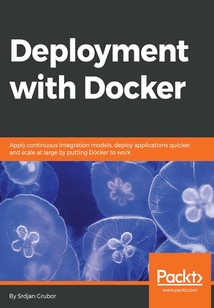舉報 

會員
Deployment with Docker
最新章節:
Summary
Thisbookisaimedatsystemadministrators,developers,DevOpsengineers,andsoftwareengineerswhowanttogetconcrete,hands-onexperiencedeployingmulti-tierwebapplicationsandcontainerizedmicroservicesusingDocker.Thisbookisalsoforanyonewhohasworkedondeployingservicesinsomefashionandwantstotaketheirsmall-scalesetupstothenextlevel(orsimplytolearnmoreabouttheprocess).
目錄(201章)
倒序
- 封面
- 版權信息
- Credits
- About the Author
- Acknowledgments
- About the Reviewer
- www.PacktPub.com
- Why subscribe?
- Customer Feedback
- Preface
- What this book covers
- What you need for this book
- Who this book is for
- Conventions
- Reader feedback
- Customer support
- Downloading the example code
- Downloading the color images of this book
- Errata
- Piracy
- Questions
- Containers - Not Just Another Buzzword
- The what and why of containers
- Docker's place
- Introduction to Docker containers
- The competition
- rkt
- System-level virtualization
- Desktop application-level virtualizations
- When should containerization be considered?
- The ideal Docker deployment
- The container mindset
- The developer workflow
- Summary
- Rolling Up the Sleeves
- Installing Docker
- Debugging containers
- Seeing what the container sees
- Our first Dockerfile
- Breaking the cache
- A container more practical
- Extending another container with FROM
- Ensuring the latest patches are included
- Applying our custom NGINX configuration
- Building and running
- Service from scratch
- Labels
- Setting environment variables with ENV
- Exposing ports
- Container security layering with limited users
- VOLUMEs and data that lives outside of the container
- Setting the working directory
- Adding files from the internet
- Changing the current user
- Putting it all together
- Summary
- Service Decomposition
- A quick review
- Docker commands
- Dockerfile commands
- Writing a real service
- An overview
- What we are going to build
- The implementation
- Web server
- Authentication
- The database
- The application server
- The main application logic
- Running it all together
- Launching
- Testing
- Limitations and issues with our implementation
- Fixing the critical issues
- Using a local volume
- Generating the credentials at runtime
- Introducing Docker networking
- Summary
- Scaling the Containers
- Service discovery
- A recap of Docker networking
- Service Discovery in depth
- Client-side discovery pattern
- Server-side discovery pattern
- Hybrid systems
- Picking the (un)available options
- Container orchestration
- State reconciliation
- Docker Swarm
- Kubernetes
- Apache Mesos/Marathon
- Cloud-based offerings
- Implementing orchestration
- Setting up a Docker Swarm cluster
- Initializing a Docker Swarm cluster
- Deploying services
- Cleaning up
- Using Swarm to orchestrate our words service
- The application server
- index.js
- The web server
- Database
- Deploying it all
- The Docker stack
- Clean up
- Summary
- Keeping the Data Persistent
- Docker image internals
- How images are layered
- Persisting the writable CoW layer(s)
- Running your own image registry
- Underlying storage driver
- aufs
- btrfs / zfs
- overlay and overlay2
- devicemapper
- Cleanup of Docker storage
- Manual cleanup
- Automatic cleanup
- Persistent storage
- Node-local storage
- Bind mounts
- Read-only bind mounts
- Named volumes
- Relocatable volumes
- Relocatable volume sync loss
- UID/GID and security considerations with volumes
- Summary
- Advanced Deployment Topics
- Advanced debugging
- Attaching to a container's process space
- Debugging the Docker daemon
- Advanced networking
- Static host configuration
- DNS configuration
- Overlay networks
- Docker built-in network mappings
- Docker communication ports
- High availability pipelines
- Container messaging
- Implementing our own messaging queue
- package.json
- index.js
- Dockerfile
- Advanced security
- Mounting the Docker socket into the container
- Host security scans
- Read-only containers
- Base system (package) updates
- Privileged mode versus --cap-add and --cap-drop
- Summary
- The Limits of Scaling and the Workarounds
- Limiting service resources
- RAM limits
- CPU limits
- Pitfall avoidance
- ulimits
- Max file descriptors
- Socket buffers
- Ephemeral ports
- Netfilter tweaks
- Multi-service containers
- Zero-downtime deployments
- Rolling service restarts
- Blue-green deployments
- Blue-turquoise-green deployments
- Summary
- Building Our Own Platform
- Configuration management
- Ansible
- Installation
- Basics
- Usage
- Amazon Web Services setup
- Creating an account
- Getting API keys
- Using the API keys
- HashiCorp Packer
- Installation
- Usage
- Choosing the right AMI base image
- Building the AMI
- Deployments to AWS
- The road to automated infrastructure deployment
- Running the deployment and tear-down playbooks
- Continuous integration/Continuous delivery
- Resource considerations
- First-deploy circular dependency
- Further generic CI/CD uses
- Summary
- Exploring the Largest-Scale Deployments
- Maintaining quorums
- Node automation
- Reactive auto-scaling
- Predictive auto-scaling
- Monitoring
- Evaluating next-gen technologies
- Technological needs
- Popularity
- A team's technical competency
- Summary 更新時間:2021-07-02 23:22:40
推薦閱讀
- Project 2007項目管理實用詳解
- 我的J2EE成功之路
- Linux Mint System Administrator’s Beginner's Guide
- STM32G4入門與電機控制實戰:基于X-CUBE-MCSDK的無刷直流電機與永磁同步電機控制實現
- Maya極速引擎:材質篇
- Docker High Performance(Second Edition)
- 運動控制系統應用與實踐
- 網站前臺設計綜合實訓
- Practical Big Data Analytics
- FPGA/CPLD應用技術(Verilog語言版)
- Salesforce Advanced Administrator Certification Guide
- Cloud Security Automation
- Hands-On Business Intelligence with Qlik Sense
- 樂高創意機器人教程(中級 上冊 10~16歲) (青少年iCAN+創新創意實踐指導叢書)
- Deep Learning Essentials
- 微機組裝與維護教程
- Learning Couchbase
- 大數據:從基礎理論到最佳實踐
- 百度智能小程序:AI賦能新機遇
- 單片機硬件接口電路及實例解析
- 傳感器與檢測技術
- 谷物干燥節能供熱技術與裝備
- 信息技術基礎與應用
- 超限學習機:理論、技術與應用
- 一站式學習C編程
- Drupal 7 Multi Sites Configuration
- PHP+MySQL+AJAX Web開發給力起飛
- ABB工業機器人進階編程與應用
- 企業網絡安全致勝寶典
- 人人可懂的數據科學

